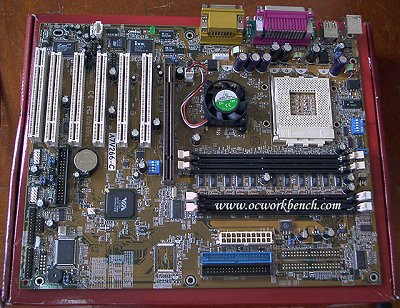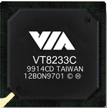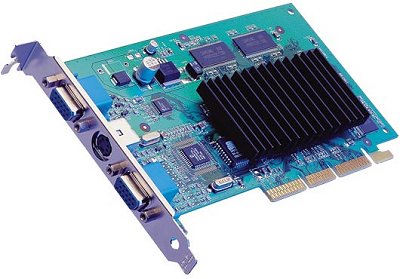Zoals beloofd heeft OCWorkbench vandaag een review online gezet van het A7V266 moederbord. Dit plankje is voorzien van de KT266 chipset, maar bezit in tegenstelling tot de meeste andere plankjes zowel DDR als SDR geheugenslots. Men bespreekt eerst uigebreid de layout en het BIOS, waarna de resultaten van een aantal benches worden getoond. In de tabellen worden de resultaten met de twee verschillende soorten geheugen van het Asus bord vergeleken met KT266 borden van Soltek en GigaByte. De andere deelnemers zijn twee AMD760 plankjes en nog twee MAGiK 1 borden. De A7V266 liet zich goed overklokken, maar presteerde niet opvallend beter of slechter dan andere borden met dezelfde chipset:
The ASUS A7V266/A7V266(C) board that I received is a engineering sample and the latest beta bios has improved results at 150Mhz. The difference between A7V266 and A7V266C is the on board Promise Raid chipset. The results are comparable to all the KT266 boards out there. Luckily we do not have to play hide-and-seek with resistors
The ASUS A7V266 provides good overclocking features. FSB at 1Mhz interval (100 to 228). Vcore is also adjustable up to 1.85v. The good news is that the multiplier can be adjusted within the BIOS. This really helps a lot. There is also a jumper which allows you to adjust the voltage supplied to the AGP card.
The Cmedia 6 channel audio which supports EAX gives you 6 channel audio. Be in a surprise with the audio quality running those demonstration softwares in the CDROM. Although in the specifications of KT266, it supports a 10/100 LAN, it seems that it is left out in this mainboard.
Bedankt voor de tip maxpayne.


 ECN is a way to improve the speed of the Internet for everyone by allowing hosts or routers to specifically notify one another when there is congestion due to heavy traffic. With the existing TCP/IP standards, the only way to detect congestion was that routers would drop packets when they had no bandwidth available. These packets would be automatically retransmitted by the sending host, but the host would (presumably) notice that packets were being dropped and would decrease its transmission rate.
ECN is a way to improve the speed of the Internet for everyone by allowing hosts or routers to specifically notify one another when there is congestion due to heavy traffic. With the existing TCP/IP standards, the only way to detect congestion was that routers would drop packets when they had no bandwidth available. These packets would be automatically retransmitted by the sending host, but the host would (presumably) notice that packets were being dropped and would decrease its transmission rate.
 A direct result of the joint technology relationship announced by the two companies in August 2000, the VIA VT8233C V-Link South Bridge chip provides a robust and feature rich solution for building network-ready mainboards and PCs for the commercial desktop and mobile markets to most PC OEM 's and motherboard manufacturers. It can be coupled with a choice of V-Link North Bridge controllers from VIA, to provide customers with the flexibility they need to meet a full spectrum of system configurations and price points.
A direct result of the joint technology relationship announced by the two companies in August 2000, the VIA VT8233C V-Link South Bridge chip provides a robust and feature rich solution for building network-ready mainboards and PCs for the commercial desktop and mobile markets to most PC OEM 's and motherboard manufacturers. It can be coupled with a choice of V-Link North Bridge controllers from VIA, to provide customers with the flexibility they need to meet a full spectrum of system configurations and price points.
 Not much of a drop, you might think, but it is a sign that demand has been growing, fuelled by Intel's various P4 price cuts over the last couple of months.
Not much of a drop, you might think, but it is a sign that demand has been growing, fuelled by Intel's various P4 price cuts over the last couple of months.
:strip_exif()/i/1000145888.jpg?f=thumbmedium)
:fill(white):strip_exif()/i/1230915745.jpg?f=thumbmedium)
:strip_exif()/i/1000148685.jpg?f=thumbmedium)

 991)
991) 1)
1) )
) All in all, it's not difficult to see that the IBM 60GXP takes what was so great about the 75GXP and improves upon it. Faster access times, better transfer rates, just flat out better scores across the board.
All in all, it's not difficult to see that the IBM 60GXP takes what was so great about the 75GXP and improves upon it. Faster access times, better transfer rates, just flat out better scores across the board.
:fill(white):strip_exif()/i/2000805106.jpeg?f=thumbmedium)

 RIMM prices are even likely to rise
soon, since the only supplier with a decent production capacity still remains Samsung
and the demand is probably due to become much stronger in May, because of the
transition to Intel P4 chips.
On the contrary DDR prices, following the present downtrend of its SDRAM cousins, are
dropping further, as more production capacity comes on stream.
RIMM prices are even likely to rise
soon, since the only supplier with a decent production capacity still remains Samsung
and the demand is probably due to become much stronger in May, because of the
transition to Intel P4 chips.
On the contrary DDR prices, following the present downtrend of its SDRAM cousins, are
dropping further, as more production capacity comes on stream.